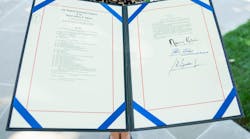Editor's note: The is Robert Schoenberger's column from the fall issue of IndustryWeek.
As I write this column in August, President Joe Biden has just signed two massive bills—the CHIPS and Science Act of 2022, which creates $52.7 billion in federal incentives to spur semiconductor manufacturing in the United States, and the Inflation Reduction Act, a slimmed-down version of his climate and health proposals. That second piece of legislation offers tax breaks for electric vehicles and supports multiple green-energy initiatives.
The new laws establish an industrial policy for the United States, something that some in the manufacturing community have been urging for decades. Bidenomics imagines America as a leading user of manufacturing technology with dominant positions in the administration’s picks for industries of the future—green energy and connected, smart devices.
That direction may seem obvious, and that could eventually become a problem.
Today, as semiconductor supply chain shortages scuttle auto production and every new device boasts connectivity, re-establishing America’s might in semiconductors sounds like a safe bet. Similarly, the EV sector has been the one bright spot for automotive growth.
However, as every financial advisor will tell you, past performance is not always an indicator of future growth.
Opponents of selecting economic targets and showering them with public cash often say government shouldn’t pick the winners and losers. In our capitalist economy, the market should decide which technologies flourish.
And, historically, governments have been very bad at it. When I lived in Mississippi from 1999 through 2003, the state’s bet on advanced polymers seemed like a good idea based on the number of chemical processing plants. That industry never flourished in the state.
More recently, the buzz around autonomous driving has spurred dozens of cities and states (Pennsylvania, Ohio, California, Michigan) to declare themselves the ideal place to develop and test driverless cars. They can’t all win.
Globally, the same is taking place with Biden’s targets. China dominated electric vehicles and materials thanks to massive government support. Taiwan and South Korea heavily subsidize semiconductors and will likely continue to do so. Is the U.S. ready to go toe-to-toe on subsidies for the next 20 years?
And most importantly, a future that seems obvious today may be very different a few years from now.
The semiconductors needed for the future: Will those be cutting-edge processors that Biden envisions Intel making in Ohio or low-priced commodity chips from Malaysia? In August, Micron, Nvidia and Intel warned that the bull run for chips may already be over with orders falling and inventories ticking up again. Are federally subsidized lithium-based car batteries the future, or will new chemistries on the horizon make those obsolete by 2030?
The argument that the U.S. must subsidize these sectors because other countries are doing so is convincing. We need a competitive playing field.
However, it will take years or even decades to know if Biden picked the right horses for his bets. For better or worse, the U.S. now effectively has an industrial policy with set goals. Let’s hope they turn out to be the right ones.





